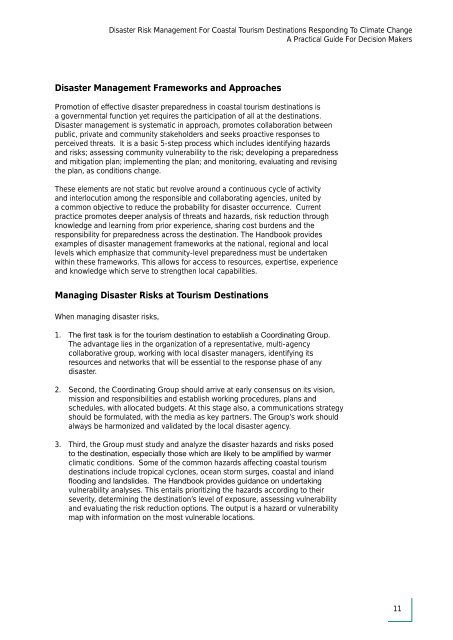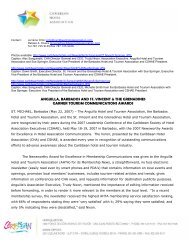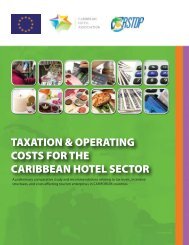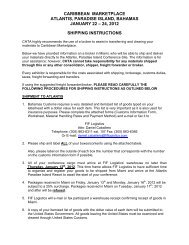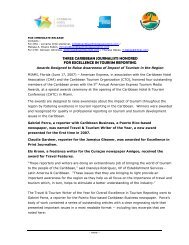Disaster Risk Management for Coastal Tourism - Caribbean Hotel ...
Disaster Risk Management for Coastal Tourism - Caribbean Hotel ...
Disaster Risk Management for Coastal Tourism - Caribbean Hotel ...
You also want an ePaper? Increase the reach of your titles
YUMPU automatically turns print PDFs into web optimized ePapers that Google loves.
<strong>Disaster</strong> <strong>Risk</strong> <strong>Management</strong> For <strong>Coastal</strong> <strong>Tourism</strong> Destinations Responding To Climate Change<br />
A Practical Guide For Decision Makers<br />
<strong>Disaster</strong> <strong>Management</strong> Frameworks and Approaches<br />
Promotion of effective disaster preparedness in coastal tourism destinations is<br />
a governmental function yet requires the participation of all at the destinations.<br />
<strong>Disaster</strong> management is systematic in approach, promotes collaboration between<br />
public, private and community stakeholders and seeks proactive responses to<br />
perceived threats. It is a basic 5-step process which includes identifying hazards<br />
and risks; assessing community vulnerability to the risk; developing a preparedness<br />
and mitigation plan; implementing the plan; and monitoring, evaluating and revising<br />
the plan, as conditions change.<br />
These elements are not static but revolve around a continuous cycle of activity<br />
and interlocution among the responsible and collaborating agencies, united by<br />
a common objective to reduce the probability <strong>for</strong> disaster occurrence. Current<br />
practice promotes deeper analysis of threats and hazards, risk reduction through<br />
knowledge and learning from prior experience, sharing cost burdens and the<br />
responsibility <strong>for</strong> preparedness across the destination. The Handbook provides<br />
examples of disaster management frameworks at the national, regional and local<br />
levels which emphasize that community-level preparedness must be undertaken<br />
within these frameworks. This allows <strong>for</strong> access to resources, expertise, experience<br />
and knowledge which serve to strengthen local capabilities.<br />
Managing <strong>Disaster</strong> <strong>Risk</strong>s at <strong>Tourism</strong> Destinations<br />
When managing disaster risks,<br />
1.<br />
2.<br />
3.<br />
<br />
The advantage lies in the organization of a representative, multi-agency<br />
collaborative group, working with local disaster managers, identifying its<br />
resources and networks that will be essential to the response phase of any<br />
disaster.<br />
Second, the Coordinating Group should arrive at early consensus on its vision,<br />
mission and responsibilities and establish working procedures, plans and<br />
schedules, with allocated budgets. At this stage also, a communications strategy<br />
should be <strong>for</strong>mulated, with the media as key partners. The Group’s work should<br />
always be harmonized and validated by the local disaster agency.<br />
Third, the Group must study and analyze the disaster hazards and risks posed<br />
<br />
climatic conditions. Some of the common hazards affecting coastal tourism<br />
destinations include tropical cyclones, ocean storm surges, coastal and inland<br />
<br />
vulnerability analyses. This entails prioritizing the hazards according to their<br />
severity, determining the destination’s level of exposure, assessing vulnerability<br />
and evaluating the risk reduction options. The output is a hazard or vulnerability<br />
map with in<strong>for</strong>mation on the most vulnerable locations.<br />
11


